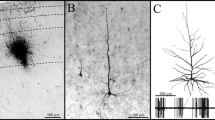Summary
Degenerating nerve fibres and boutons were searched with the aid of the electron microscope in the arcuate nucleus of rats 2–7 days after bilateral destruction of the retina.
In the arcuate nucleus of the control animals as well as in the operated animals, 4 types of boutons were distinguished on the basis of vesicular contents and glial ensheathment. In the operated animals changes interpreted as degenerating were found in small myelinated axons and boutons of type II (boutons containing both synaptic and granular vesicles). The changes were similar to those described in the literature as the “dark” type of degeneration in experimentally interrupted axons and boutons. Similar changes were not found in the unoperated animals. The conclusion is reached, that a small number of fibres of the optic tract reach the arcuate nucleus to terminate here.
Similar content being viewed by others
References
Aghajanian, G.K., Bloom, F.E., Sheard, M.H.: Electron, microscopy of degeneration within the serotonin pathway of rat brain. Brain Res. 13, 266–273 (1969).
Alksne, J.F., Blackstad, Th.W., Walberg, F., White, L.E., Jr.,: Electron microscopy of axon degeneration: a valuable tool in experimental neuroanatomy. Ergebn. Anat. Entwickl.-Gesch. 39, 1–32 (1966).
Blackstad, Th. W.: Mapping of experimental axon degeneration by electron microscopy of Golgi preparations. Z. Zellforsch. 67, 819–834 (1965).
Brody, I.: The keratinization of epidermal cells of normal guinea pig skin as revealed by electron microscopy. J. Ultrastruct. Res. 2, 482–511 (1959).
Christ, J.F.: Hypothalamic-hypophyseal neurosecretion (Histologic changes in the neurosecretory system of the rabbit after electrical stimulation). Mem. Soc. Endocr. 9, 18–26 (1960).
Cowan, W.M., Powell, T.P.S.: A note on terminal degeneration in the hypothalamus. J. Anat. (Lond.) 90, 188–192 (1956).
Etcheverry, G.J., Iraldi, A.P.: Ultrastructure of neurons in the arcuate nucleus of the rat. Anat. Rec. 160, 239–254 (1968).
Gordon, M.K., Bench, K.G., Deanin, G.G., Gordon, M.W.: Histochemical and biochemical study of synaptic lysosomes. Nature (Lond.) 217, 523–527 (1968).
Gray, E.G.: Axosomatic and axodendritic synapses of the cerebral cortex: an electron microscope study. J. Anat. (Lond.) 93, 420–433 (1959).
—: Electron microscopy of excitatory and inhibitory synapses: a brief review. Prog. Brain Res. 31, 141–155 (1969).
—, Guillery, R.W.: Synaptic morphology in the normal and degenerating nervous system. Int. Rev. Cytol. 19, 111–182 (1966).
Guillery, R.W.: Some electron microscopical observations of degenerative changes in central nervous synapses. Prog. Brain Res. 14, 57–76 (1965).
Heimer, L.: Silver impregnation of degenerating axons and their terminals in epon-araldite sections. Brain Res. 12, 246–249 (1969).
Holländer, H., Vaaland, J.L.: A reliable staining method for semi-thin sections in experimental neuroanatomy. Brain Res. 10, 120–126 (1968).
Monroe, B.J.: A comparative study of the ultrastructure of the median eminence, infundibular stem and neural lobe of the hypophysis of the rat. Z. Zellforsch. 76, 405–432 (1967).
Mugnaini, E., Walberg, F.: An experimental electron microscopical study on the mode of termination of cerebellar corticovestibular fibers in the cat lateral vestibular nucleus (Deiter's nucleus). Exp. Brain Res. 4, 212–236 (1967).
—, Brodal, A.: Mode of termination of primary vestibular fibers in the lateral vestibular nucleus. An experimental electron microscopical study in the cat. Exp. Brain Res. 4, 187–211 (1967).
Pease, D.C.: Histological techniques for electron microscopy. New York: Academic Press 1964.
Sousa-Pinto, A., Castro-Correia, J.: Light microscopic observations on the possible retinohypothalamic projection in the rat. Exp. Brain Res. 11, 515–527 (1970).
Szentágothai, J., Elerkó, B., Mess, B., Halász, B.: Hypothalamic control of the anterior pituitary. An experimental-morphologic study. Budapest: Akadémiai Kiadó 1968.
Venable, J.H., Coggeshall, R.: A simplified lead citrate stain for use in electron microscopy. J. Cell. Biol. 25, 407–408 (1965).
Webster, H. de F., Spiro, D., Waksman, B., Adams, R.D.: Phase and electron microscopic studies of experimental demyelination. II. Schwann cell changes in guinea-pig sciatic nerve during experimental diphteric neuritis. J. Neuropath. exp. Neurol. 20, 5–34 (1961).
Zambrano, D.: The arcuate complex of the female rat during the sexual cycle. An electron microscopic study. Z. Zellforsch. 93, 560–570 (1969).
Author information
Authors and Affiliations
Additional information
Financial support for this work was given by the “Calouste Gulbenkian Foundation” and by the “3rd Development Plan” of the Portuguese Ministry of Education.
Rights and permissions
About this article
Cite this article
Sousa-Pinto, A. Electron microscopic observations on the possible retinohypothalamic projection in the rat. Exp Brain Res 11, 528–538 (1970). https://doi.org/10.1007/BF00233973
Received:
Issue Date:
DOI: https://doi.org/10.1007/BF00233973



